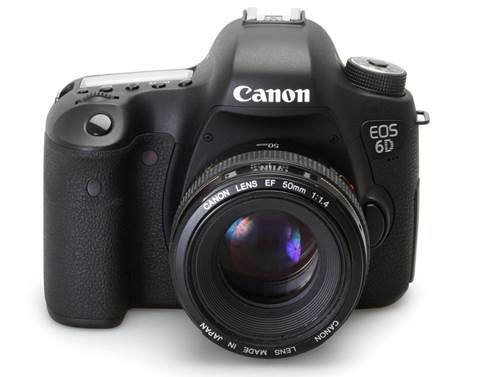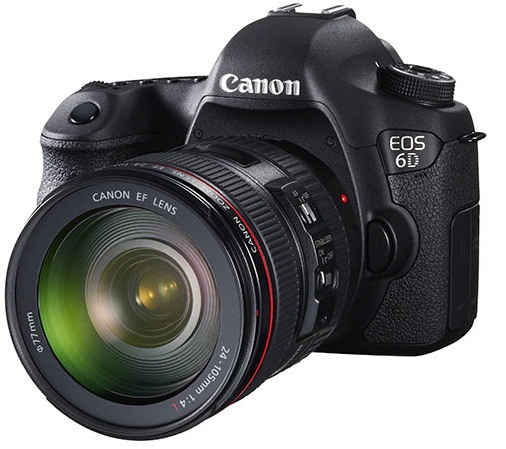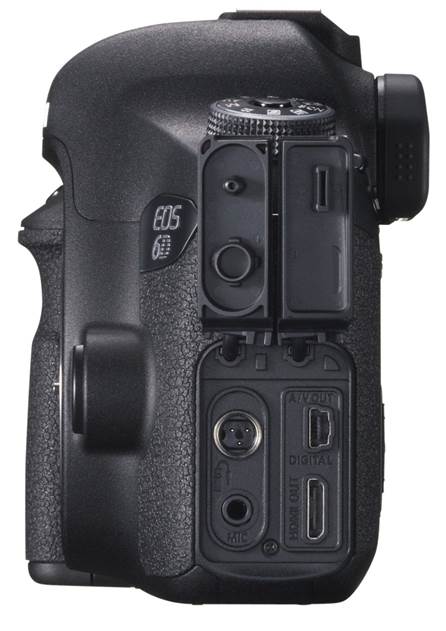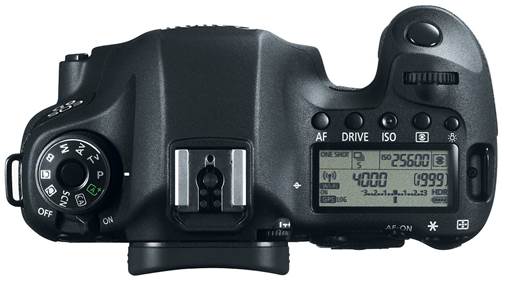The Canon EOS 6D comes with built-in Wi-Fi
and GPS. Inside is a brand-new 20.2MP full-frame CMOS sensor with a single
DIGIC 5+ image processor, the same processor as seen on the Canon 5D Mark III.
While a top-tier camera like the 5D Mark III should offer little disappointment
(except for the hole in your wallet), the Canon 6D is a camera built with
trade-offs in order to sell at a lower price. Read on to find out if those
trade-offs are worth the savings.

The
Canon EOS 6D comes with built-in Wi-Fi and GPS.
Design & Handling
Imagine putting a full-frame sensor into a
Canon 60D, and that’s essentially what the 6D body looks and feels like. The
familiar Canon joystick is absent here, taking its place is the 8-way d-pad
from the 60D.It retains two control dials (top dial and the back scroll wheel),
as well as the top LCD panel.
The body is 680g; 180g less than the 5D
Mark III and smaller, but still hefty. The front grip and back thumb-rest
provide a good handle on the camera. Its magnesium alloy body is both dust- and
drip-proof, so you won’t have to run for cover at the first sign of a drizzle.
The rear 3” LCD has a luxurious resolution of 1.04 million dots, making the
screen bright and clear.

Imagine
putting a full-frame sensor into a Canon 60D, and that’s essentially what the
6D body looks and feels like.
Using the 6D is more reminiscent of using
the 60D than the 5D Mark III. Whether this is a good thing or not depends on
where you’re coming from; if you’re upgrading from the 60D or below, than you
might welcome the simplified controls and feel right at home. If you’re
downgrading from the flagship full-frame cameras, you might be disappointed to
find that the 6D lacks many of the advanced handling options available on those
cameras.
For one, there are only 11 AF points. So
you can only choose between automatic Basic Zone focus (by selecting from a
single AF point among the 11) and manual focus. Having 11 AF points doesn’t
sound like a lot, and they aren’t. Quite unlike the Nikon D600, which has 39 AF
points with nine cross-types (the 6D has one cross-type). Like the D600, the
6D’s 11 points are also concentrated near the center. It does affect the way
you shoot, there were times when we had to adjust our framing so that we could
get a precise lock on a particular part of our subject.
Apart from the limited number and spread of
AF points, the 6D’s AF system is very, very good. Even in low-light, the 6D
recognized and snapped on subjects quickly. Surprisingly, the 6D’s AF system is
rated a stop lower than the 5D Mark III; -3 EV compared to -2 EV. So the odd
conclusion is, yes the number of AF points as well as the spread is a
trade-off, but in return the AF is fast and accurate.

Apart
from the limited number and spread of AF points, the 6D’s AF system is very,
very good.
The rest of the 6D feels rather
comfortable. The four dedicated buttons on the top plate give direct access to
AF, Drive, ISO and Metering, with a fifth button lighting up the LCD panel. The
Q button brings up the Quick Menu, where you can see what your settings are at
a glance and quickly change them.
The interesting thing about the 6D is that
it’s Canon’s first DSLR camera with both Wi-Fi and GPS built-in. With the
built-in Wi-Fi feature, you can connect the 6D to a great many things: Another
camera, a smartphone, to a printer, Canon’s Image Gateway web service and to a
media player.
To connect it to a smartphone, you need to
download the free EOS Remote app. Connecting is rather easy; the 6D will
provide you with a password, and you connect to it as a local network from your
smartphone. The app lets you take over the camera, with a real-time live view
broadcast from the 6D, and you can remotely trigger the shutter with your
smartphone.
It’s quite an interesting feature but its
main drawback is lag. First, there’s a lag between what the camera sees and
what you see on your smartphone. Second, there’s a lag between when you press
the shutter release on the phone and when the camera snaps the picture.
The other thing you can do with the app is
preview all the images on the camera. You can then download selected images,
but they’ll be transmitted over at a lower resolution of 2.5MP (1920 x 1280
pixels). With the 6D, you can snap a photo, transmit it over to your phone,
apply your favorite filter using your favorite app, and upload it to your
favorite social network – all without the need for a PC.
Image Performance
The images are really what you’d buy the
Canon 6D for. Long story short: They’re outstanding. For anyone who’s only shot
previously with smaller sensors, full-frame images will be a revelation.
Photographs are richer, with more detail, color and depth of field.
The Canon 6D captures a very high 2600 x
2400 LPH (vertical and horizontal) amount of detail on our resolution chart. In
general, images are very clean and stay that way into the high ISO ranges. The
first sign that noise starts to smudge details start from ISO 1600, and we’d
say that images remain usable up to ISO 25,600 (the native limit) if you’re
willing to clean up or endure some noise (or are showing images online).
At ISO 51,200 there’s too much visible
noise. 6D handles image noise admirably, it’s kept to a minimum and most of
what appears is luminance noise, with little to no color noise. Except for the
fact that the 6D produces a slightly smaller image at 20.2MP, noise performance
looks virtually identical to the 5D Mark III’s 22.3MP images.

The
images are really what you’d buy the Canon 6D for.
Of course, you’re paying for more than just
ISO performance with the 5D Mark III. While the 5D Mark III can capture up to 6
frames per second, the 6D does a slower 4.5 fps. Another minus point that might
dint perfectionists is that the viewfinder only offers 97% coverage. Some might
not miss it, but part of the appeal of full-frame cameras have been their
large, luxurious viewfinders with 100% coverage, so it’s nit-picking but still
disappointing.
Conclusion
In summary, the Canon 6D feels more like a
beefed-up 60D than a simplified 5D Mark III. Handling and customization is kept
to a minimum, and the joystick is conspicuously absent. There are only 11 AF
points with limited coverage, which is disappointing.
Inside, the 6D is all 5D Mark III. While
not keeping the more expensive camera’s high frame-rates, the 6D retains the
same image quality. Without that joystick however, it becomes harder to change
AF points.
The 6D holds the honor of being the first
Canon DSLR to come with built-in Wi-Fi and GPS. If it were up to us, Wi-Fi
should be built into every DSLR camera released in 2012. It’s about time that
we can send photos through the air to our smartphones and then share them with
the world without needing a PC in-between. Keep in mind though, that there is a
variant 6D which comes without Wi-Fi or GPS.
|
Basic
Specifications
§ Part
Code: 8035B002
§ Review
Date: 29 Jan 2013
§ Rating:
CCD effective megapixels: 20.0 megapixels; CCD size: 36x24mm
§ Viewfinder:
optical TTL
§ Viewfinder
magnification, coverage: 0.71x, 97%
§ LCD
screen size: 3.0in
§ LCD
screen resolution: 1,040,000 pixels
§ Image
stabilization: Available in lenses
§ Maximum
image resolution: 5,472x3,648
§ File
formats: JPEG, RAW; QuickTime (AVC)
|